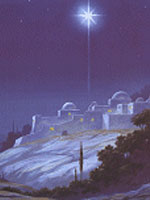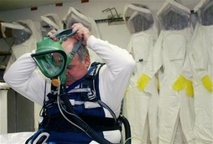|
|
By Thomas
- December 25, 2008
 A comet, an eclipse, a supernova, an alignment of planets - was the Star of Bethlehem, said to have led the wise men to the Baby Jesus, a real astronomical event? Some 2,000 years ago, wise men saw an incredible star shining over the Holy Land. It was their signal to embark on an epic journey to visit the new Messiah. But what exactly was the Star of Bethlehem?
Modern science is unravelling the mystery behind one of the most famous astronomical stories in history. New developments in technology allow astronomers to map the ancient night skies with extraordinary accuracy.
As they study the movements of the planets and stars, experts are challenging the traditional assumption that it was a blazing comet - instead there are several unusual astronomical events that the wise men could have seen in the skies. The Bible tells us remarkably little about the star, with only the Gospel of St Matthew mentioning it. He records the wise men asking: "Where is he who has been born King of the Jews? For we have seen his star in the east and have come to worship him."
No date or detailed description is given. Even the identity of the men is obscure. Rather than the kings of popular imagination, the wise men are thought to have been priests from Persia, known as Magi. Keen astrologers who looked to the stars for guidance, the Magi combined science with faith to predict the birth of a new Messiah.
So what prompted them to travel to Bethlehem? Most experts agree Jesus was born in 4BC or earlier, as King Herod, who ruled over Judea at the time, is recorded as dying in 4BC. Now astronomers have identified four celestial events in this period that could have been the Star of Bethlehem.
By Britney
- December 20, 2008
Men make up four-fifths of the world's skydivers and two-thirds of all rock climbers, and a new study suggests they do it for more than just the thrill.
Men may flirt with risk because they think it will help them score women.
Evolutionary psychologists have long believed that women are choosier about men than men are about women. It's not (just) because girls want to make life difficult for guys; it's because, at least historically, women have had to pick men who could provide for them and their children. This pressure forces males to work harder to prove their worth to females and out-compete other guys in the running. Social psychologists at Florida State University wondered: could risk-taking be one of the ways in which men show off their strength, ambition and confidence to potential lovers?
To find out, they asked 134 undergraduate male and female psychology students to participate in an experiment. They wanted to see whether men would take more risks if they were "in the mood" and if the men thought there were beautiful women around for them to woo.
By Thomas
- December 15, 2008

WASHINGTON (Reuters) – Researchers have identified at least six new gene mutations linked to obesity and said on Sunday they point to ways the brain and nervous system control eating and metabolism.
Joel Hirschhorn at Children's Hospital and Harvard Medical School in Boston led a team called Genetic Investigation of Anthropometric Traits or GIANT to screen 15 different studies of the entire human genetic map and pinpoint the six new genetic variations.
"Today's findings are a major step forward in understanding how the human body regulates weight," Dr. Alan Guttmacher, Acting director of the National Human Genome Research Institute, said in a statement.
"This study essentially doubles in one fell swoop the number of known and replicated genetic factors contributing to obesity as a public health problem," added Dr. Kari Stefansson, Chief Executive Officer of DeCODE Genetics of Iceland, who led a team that made similar findings in a separate study.
The GIANT team found variations in six genes -- TMEM18, KCTD15, GNPDA2, SH2B1, MTCH2 and NEGR1 -- were strongly associated with a height-to-weight ratio known as body mass index or BMI.
By Alexander
- December 04, 2008

CHICAGO (Reuters) – A new dry wipe can clean up chemical agents such as mustard gas, giving soldiers a more convenient way to deal with toxic materials on the battlefield, U.S. researchers said on Wednesday.
The wipe was developed by researchers at Texas Tech University in Lubbock in response to a call by the U.S. military for better ways to decontaminate military personnel and equipment.
"This is the first time this kind of wipe has been developed and it has been tested against a real chemical agent," Seshadri Ramkumar of Texas Tech, who developed the wipe, said in a telephone interview.
In tests performed at the Lawrence Livermore National Laboratory in California using mustard gas and other toxic chemicals, the wipe outperformed 30 different materials, including some currently used in military decontamination kits.
By Alexander
- December 04, 2008

CHICAGO (Reuters) – An analysis of rings on a stalagmite from a cave near Jerusalem reveals a drier climate in the region at a time in history when the Roman and Byzantine empires were in decline, scientists reported on Thursday.
University of Wisconsin geologists analyzed the chemical composition of individual rings as small as
one-hundredth of a millimeter across that formed the stalagmite growing up from the floor of the Soreq Cave near Jerusalem between 200 B.C. and 1100 A.D..
|
|
|
|
|
|  |
|
 A comet, an eclipse, a supernova, an alignment of planets - was the Star of Bethlehem, said to have led the wise men to the Baby Jesus, a real astronomical event? Some 2,000 years ago, wise men saw an incredible star shining over the Holy Land. It was their signal to embark on an epic journey to visit the new Messiah. But what exactly was the Star of Bethlehem?
A comet, an eclipse, a supernova, an alignment of planets - was the Star of Bethlehem, said to have led the wise men to the Baby Jesus, a real astronomical event? Some 2,000 years ago, wise men saw an incredible star shining over the Holy Land. It was their signal to embark on an epic journey to visit the new Messiah. But what exactly was the Star of Bethlehem?
 We recommend
We recommend





 CHICAGO (Reuters) – An analysis of rings on a stalagmite from a cave near Jerusalem reveals a drier climate in the region at a time in history when the Roman and Byzantine empires were in decline, scientists reported on Thursday.
University of Wisconsin geologists analyzed the chemical composition of individual rings as small as
one-hundredth of a millimeter across that formed the stalagmite growing up from the floor of the Soreq Cave near Jerusalem between 200 B.C. and 1100 A.D..
CHICAGO (Reuters) – An analysis of rings on a stalagmite from a cave near Jerusalem reveals a drier climate in the region at a time in history when the Roman and Byzantine empires were in decline, scientists reported on Thursday.
University of Wisconsin geologists analyzed the chemical composition of individual rings as small as
one-hundredth of a millimeter across that formed the stalagmite growing up from the floor of the Soreq Cave near Jerusalem between 200 B.C. and 1100 A.D..
